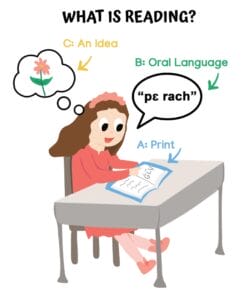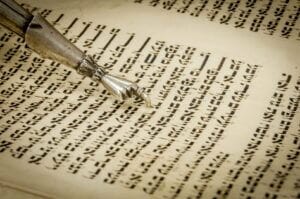Throughout our long and fascinating history, Jewish communities in far-flung lands have maintained their own specific ways of pronouncing the vowels and consonants they read in the Torah and Torah literature. Despite these variations, there is unity. The Jewish people are one nation, with one G-d, one Torah, and one Land of Israel.
Indeed, the very concept of respecting and strongly adhering to our ancestral traditions is a common value that unites us. From the beginning, the Twelve Tribes of Israel represented different spiritual strengths. They had their own regional areas, their own ways of serving Hashem, and they also had different accents and pronunciations. They were all needed to make the Jewish people whole.
Now these tradition communities live side by side in modern cities, sharing Jewish life together. This is beautiful, yet it may present a challenge for schools who are teaching students with different backgrounds. For instance, a predominantly Ashkenazi school may have a handful of children with a Sephardi background. A Chassidic school might include some Israeli students. Or a school that teaches in Modern Hebrew may have a mixture of students in its classrooms. How can we help our students maintain their specific heritage while we create pluralistic community? How we include all specific cultures and accents while we teach children Kriah, Torah and Tefilah?

What are our different accents and how did this come about?
What we call the Sephardi accent represents a large swath of pronunciations that have been used in Spain, Morocco, Iraq, Aleppo (Syria) and other parts of the Middle East, Italy, Sephardic communities in Europe and now across the globe. Each regional version has its unique qualities, but the commonality between them is that patach and kamatz are pronounced the same (in most situations), and there is also no distinction between tzeireh and segol. Scholars trace this feature from what is called the “Palestinian pronunciation” of 6th-9th century C.E.This popular accent probably traveled first to Italy and from there to Spain and the other locations. It may even have been the way the early Ashkenazi Jews pronounced Hebrew as well. The Sephardi accent has specific rules on how (and when) the sh’va is pronounced as a moving or a resting sh’va. Some communities make sure to “double” the pronunciation of a letter with a dagesh under certain circumstances, but not under others. Chet, chaf, and hey will probably sound different, samech, sin, and shin and tzaddi(k), ayin and aleph can be easily told apart. In modern Israel, however, younger generations of speakers may not be retaining these features so strongly.
The Ashkenazi accent contains many different, well-known geographical and communal groupings, but they all have several things in common. We all know that the Ashkenazi accent group differentiates between taf and “saf” – with and without a dagesh, and that so many other letters are not distinguished by sound: alef, ayin, chet and chaf, quf and kaf, and so on. But did you notice that the Ashkenazi accent is the only one that distinguishes clearly between all of the seven nekudos? (The Academy of the Hebrew Language (n.d.) Historians wonder if this means that the Ashkenazi accent continues an unbroken chain from the earliest times. There may have been a rejuvenation of pronunciation by traveling scholars after the 13th century… or the accents may simply have been affected by the various Yiddish dialects people used in everyday life. Cholam, for instance, has been pronounced by different communities as “aw”, “o”, “oy”, or even “ay”. In any case, the accent is still changing: in some communities in modern America a cholam is pronounced as an American-English sounding /o/ and a resh as an American rhotic /ɹ/.

Modern Israeli Hebrew comes in several flavors, influenced by the 3 main accents as well as by conscious decisions made by the Hebrew Academy of Language while Ivrit was being “resurrected” in the early 20th century. Modern Ivrit continues to change, blending traditional pronunciations and introducing simplifications over time – a natural process for a living language, while the meticulously-guarded community traditions of pronunciation handed down by our chachamim and rabbanim through the ages also continue to preserve our unique ancestral links to the past.
So is it deles or delet? Is it bet or bais? Tav or Sav? Bayis or bayit? Etrog or esrog? Actually maybe it is deleth, beth and thav, bayith and ethrog.

The traditional Yemenite accent gives us insight into how Hebrew was pronounced so very long ago. For instance, the Yemenite (Temani) Jews are considered by scholars to have retained many features of the Babylonian pronunciation from the time of the Geonim. In fact, the Temanim also used, until fairly recently, the Babylonian system of writing vowels, using different symbols from our familiar ones, and writing them above each consonant, not below them. The Yemenite accent carefully differentiates each Hebrew consonant, and it “pronounces” the dagesh. Yet in a Yemenite accent, different vowels can sound the same: a Temani patach and a tzeireh sound the same to the ear, and cholam, too, can sound like a tzeireh in some Yemenite regional dialects. The letter gimmel has multiple geographical variations. The accent also applies its own specific rules to saying the sh’va, depending on where it occurs in the word. And of course, this all changes for the official Torah reading accent!

How can we be mindful of each student’s unique traditions while still teaching consistently?What can we do when a student comes from a home where a different accent is used? How can we create a welcoming, validating atmosphere for learning within your classroom structure and school policies?
- If a student’s natural accent is different from the one you’re presenting in class, select a consistent approach that will support beginners without confusing them as you establish reading for meaning and for pleasure.
- If you are teaching with an Ashkenazi accent and have Israeli-accented students, help them make the linguistic connection by incorporating visuals. When they learn the word ‘דג’ in an unfamiliar Ashkenazi accent but can see a picture of a fish with it, watch them light up with understanding as they learn to “code-switch”, and realize that the syllables they are reading have meaning to them already.
- Ask students, “Can you help me say it your way?” or “How do you say it at home?”
- Children usually find variations fascinating. When skill- and age-appropriate, bring these differences to the attention of all the children. For example: show them the letter ב and introduce the children to all the various ways of pronouncing its name: “bet”, “beit”, “beth”, and “beis”.
- With reading exercises, once in a while as a fun activity you can demonstrate and practice together different “ways” of reading it. This adds a richness to the learning that will especially stimulate your gifted learners, who love thinking about things from multiple angles.
When teaching multiple students with different accents in one classroom, here’s how you can assess each one’s accuracy:
- Children who speak with an Ashkenazi accent should be held responsible for all distinctions between kamatz and patach, taf and saf etc.
- With Sephardi-accented students who have been exposed to (or are learning) the Ashkenazi pronunciation, be lenient and be alert. Straighten out any confusion: sometimes pronouncing patach as kamatz, and not just kamatz as patach.
- Use your discretion, and be aware of when to correct errors—not in the midst of a reading or writing exercise that they’re enjoying or using to work on fluency. We want to train students correctly while keeping them emotionally open.
- Note that writing and spelling with the proper nikudot is a big challenge for Sephardi and Modern Hebrew speakers, and we would consider that an advanced skill to be learned at an older age..
The bottom line is if we call the second letter bet, beis, beth, bait; we are all one nation with one heart. We have one G-d, one Torah and on Israel. We may find small superficial, nuanced amongst us but this is minuscule in comparison to what we have in common.
Jewish Virtual Library. (n.d.). Hebrew: Pronunciations of Hebrew. In jewishvirtuallibrary.org encyclopedia. Retrieved August 8, 2023, https://www.jewishvirtuallibrary.org/pronunciations-of-hebrew
The Academy of the Hebrew Language (n.d.) נושא ניקוד טברני. In האקדמיה ללשון העברית. Retrieved August 8, 2023, https://hebrew-academy.org.il/category/%D7%A0%D7%99%D7%A7%D7%95%D7%93-%D7%98%D7%91%D7%A8%D7%A0%D7%99/
Please comment if you have some more tips or strategies that you add this list.






